Israel-Hamas War: What happened on day 116?
IDF close to defeating Hamas in Khan Yunis, half of terror group's forces 'out of combat' • Hamas 'studying' Gaza hostage deal, Haniyeh says
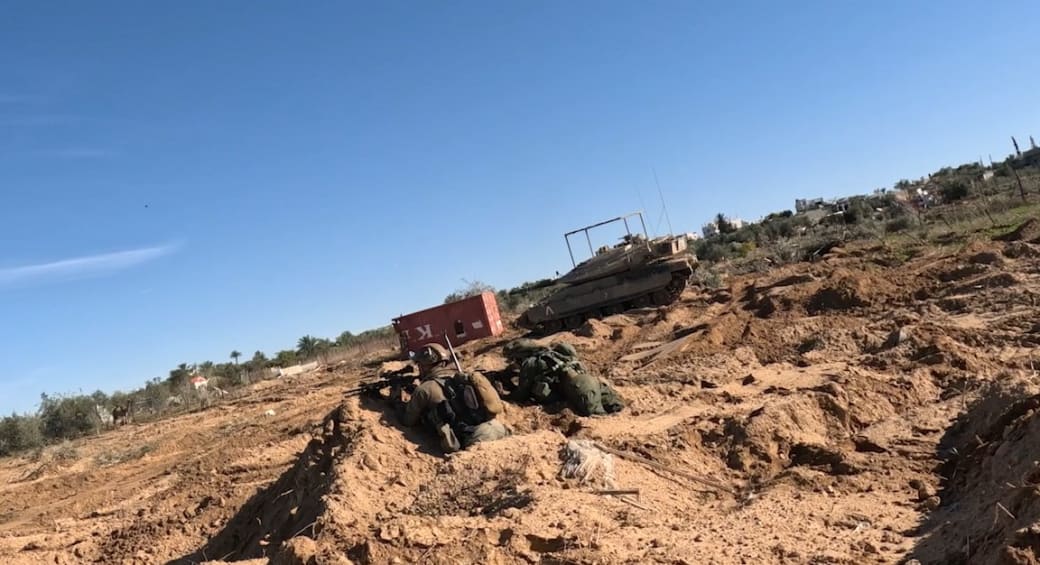

Ceasefire deal may be agreed to by next week - report

A ceasefire agreement which would include a hostage deal is expected to be reached next week, Kan 11 reported on Tuesday, citing Qatari sources.
Go to the full article >>Israel's emergency gov't will collapse if Netanyahu stalls hostage deal
Israel's emergency war government will collapse if Prime Minister Benjamin Netanyahu refuses an acceptable deal for the release of Hamas hostages from Gaza, National Unity minister Chili Tropper warned on Tuesday morning.
Amid pressure on the government to finalize a deal with Hamas for the release of the remaining 136 hostages, Tropper noted that ending the war in Gaza is not an option.
"We would have to pay a heavy price (in a hostage deal) but stopping the war is a price Israel is unwilling to pay," Tropper added. "If there is a deal we can live with and Netanyahu doesn't sign on it, we will leave the government.
"Even if we replaced Netanyahu, the aim to destroy Hamas will not change."
Go to the full article >>Israel, Egypt defense heads talk IDF plans in Gaza's Rafah - report
Shin Bet director Ronen Bar met on Monday night with Egyptian intelligence chief Abbas Kamel amid reports that Israel had informed Egypt of its intention to launch an invasion into Gaza's Rafah, Axios reported on Tuesday morning citing two Israeli sources.
Topics of discussion in the meeting did not include the release of Gaza hostages, the report noted, instead focusing on Israel-Egypt ties and efforts to foil the smuggling of weaponry from Egypt into the Gaza Strip.
Go to the full article >>Israel foils 'October 7-style' terror attack in raid on Jenin hospital, three killed
Terrorists used the Jenin hospital as a secret base of operations as he was planning an infiltration attack akin to and inspired by the October 7 massacre.
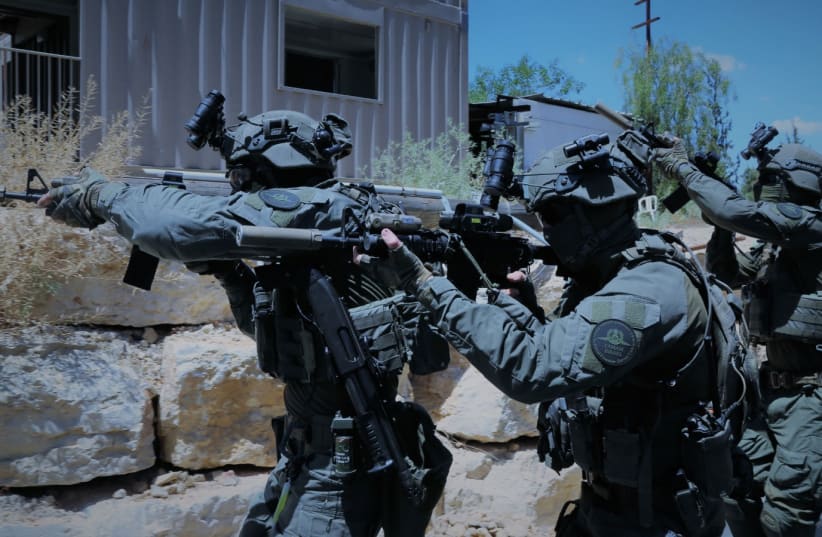
Israeli counterterrorism forces foiled an October 7-inspired terror attack overnight on Tuesday, targeting a cell hiding and planning the attack from the Ibn Sina hospital in Jenin, the West Bank.
According to a joint statement by the IDF, Israel Police's YAMAM counterterrorism forces, and the Shin Bet, wanted Hamas terrorist Mohammad Jalamna was killed during the operation, along with two fellow terrorists who hid alongside him at the hospital.
27-year-old Jalamna, a resident of the Jenin refugee camp, held direct communications with Hamas leadership abroad. According to the statement, he was responsible for transferring weaponry and ammunition to Hamas terrorists across the West Bank for shooting attacks targeting Israelis.
'Planned to carry out October 7-inspired attack'
Furthermore, Jalamna used the Jenin hospital as a secret base of operations as he was planning an infiltration attack akin to and inspired by the October 7 massacre, it added.
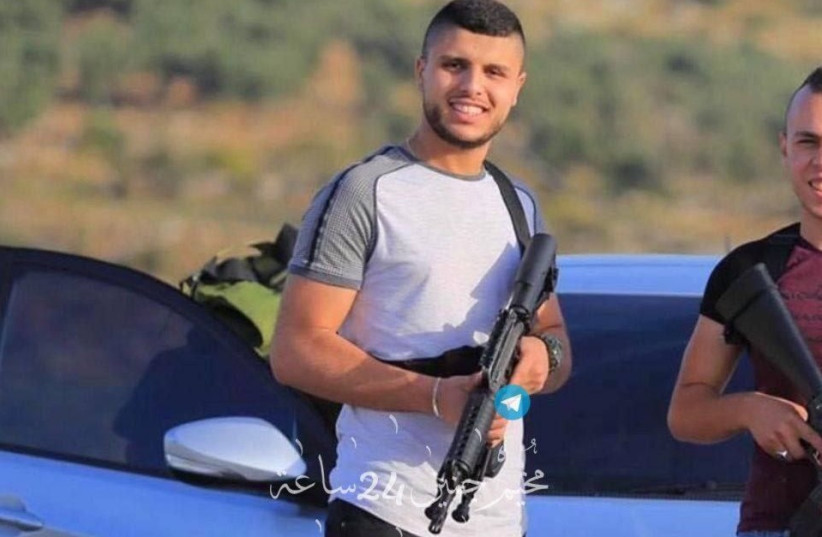
Along with Jalamneh, Mohammed and Basel Ghazawi, brothers and Palestinian terrorists, were also killed by Israeli forces. Mohammed was a terrorist operative of the Jenin battalions who was involved in numerous attacks including firing at IDF soldiers in the area in recent weeks, the IDF said.
Basel was a Palestinian Islamic Jihad operative involved in terror activities in the area.
Security forces said using hospitals as bases of terror isn't something new
The security forces stated that for a long time, a large number of wanted persons had been hiding in hospitals and were using them as a base for planning terror attacks and carrying them out, and that they believed that the hospitals would serve as protection against Israeli security forces.
The three terrorists were neutralized by a combination of Yamam forces and the IDF, which raided the hospital, and within minutes, eliminated the terrorists while they were in a hidden room on one of the floors.
The statement said that the operation was made possible due to accurate intelligence received before the operation, and an operation of this nature was unprecedented.
One senior official stated, "There are no cities of refuge in the West Bank and there will not be - every terrorist should know this. The hand of the IDF and the security establishment will reach everyone."
Go to the full article >>Israeli intelligence accuses 190 UNRWA staff of Hamas, Islamic Jihad roles
The six-page dossier, seen by Reuters, alleges that some 190 UNRWA employees, including teachers, have doubled as Hamas or Islamic Jihad militants. It has names and pictures for 11 of them.
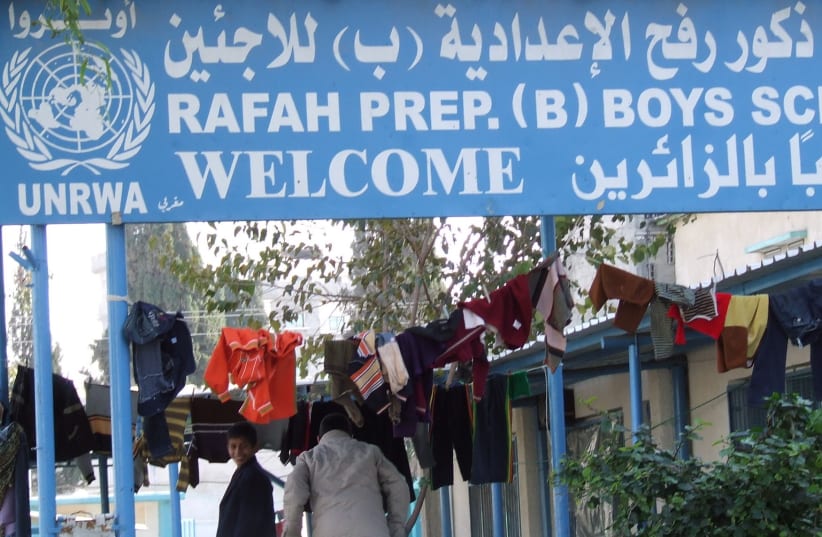
Israel’s intelligence dossier on UNRWA links to Hamas and the October 7 attack was broader than first indicated, Reuters reported Monday. It included allegations against 190 employees, including teachers, who have doubled as Hamas or Islamic Jihad terrorists.
According to Israel, 12 of those named in the dossier were involved in the October attack, it has names and pictures for 11 of them, according to Reuters.
The dossier said one of the 11 is a school counselor who helped his son abduct a woman during the October 7 Hamas infiltration in which 1,200 people were killed and 253 were kidnapped.
An UNRWA social worker is accused of unspecified involvement in the transfer to Gaza of a slain Israeli soldier’s corpse and of coordinating the movements of pickup trucks used by the terrorists and of weapons supplies, the report said.
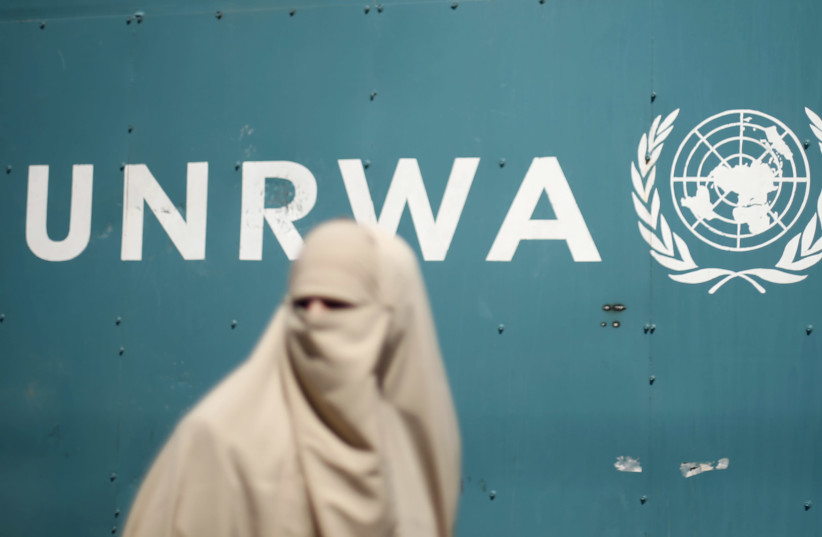
A third Palestinian in the dossier is accused of taking part in a rampage in Be’eri, one-tenth of whose residents were killed. A fourth is accused of participating in an attack on Re’im, where there is an army base, and also was the site of a rave where more than 360 revelers were killed.
UNRWA Commissioner-General Philippe Lazzarini should resign, Foreign Minister Israel Katz said.
“UNRWA employees participated in the massacre of October 7,” he said. “Lazzarini should conclude and resign.”
Palestinian Authority Prime Minister Mohammad Shtayyeh on Monday said Israel had conducted a “premeditated political attack” on the agency, which it has long criticized, and called for restoration of aid funds.
Israel has not made its allegations public, but the dossier has been leaked to major media outlets.
The dossier was shown to Reuters by a source who could not be identified by name or nationality. The source said it had been compiled by Israeli intelligence and shared with the United States, which on Friday suspended funding for UNRWA.
An Israeli official told Reuters the 190 mentioned in the dossier were “hardened fighters, killers,” whereas overall, some 10% of UNRWA staff were believed to have more general affiliation with Hamas and Islamic Jihad. The agency employs 13,000 people in Gaza.
“From intelligence information, documents, and identity cards seized during the fighting, it is now possible to flag around 190 Hamas and PIJ terrorist operatives who serve as UNRWA employees,” according to the Hebrew-language dossier.
It accuses Hamas of “methodically and deliberately deploying its terrorist infrastructure in a wide range of UN facilities and assets,” including schools. Hamas denies that.
Two of the alleged Hamas operatives cited in the dossier are described as “eliminated” or killed by Israeli forces. A 12th Palestinian, whose name and picture are provided, is said to have no factional membership and to have infiltrated Israel on October 7.
Also on the list of 12 men are a UNRWA teacher accused of arming himself with an anti-tank rocket, another teacher accused of filming a hostage, and the manager of a shop in a UNRWA school accused of opening a war room for Islamic Jihad.
“The terrorist organizations are cynically exploiting the residents of the Strip and the international organizations whose mission is to provide aid... and in doing so are causing de facto harm to residents of the Strip,” the dossier said.
Over the weekend, UN Secretary-General Antonio Guterres vowed to hold to account any employee involved in “abhorrent” acts, but he implored nations to keep funding UNRWA for humanitarian reasons.
“The tens of thousands of men and women who work for UNRWA, many in some of the most dangerous situations for humanitarian workers, should not be penalized,” Guterres said. “The dire needs of the desperate populations they serve must be met.”
In the wake of the report, at least 15 nations have suspended funding to UNRWA, and the European Commission has called for an investigation into its Gaza staff to ensure that they did not participate in the October 7 Hamas-led massacre.
“A review of all UNRWA staff should be launched soonest to confirm that they did not participate in the attacks,” the European Commission said.
UNRWA fired nine of the accused staff members and has launched an investigation into the complaint.
European Union member states have been split on how best to respond to the allegations. At least eight of its members have suspended pledged funding for the 2024 budget pending the results of a UNRWA-led investigation.
Ireland and Norway have said funding should continue for the agency, which has been the main provider of humanitarian aid to Gaza during the Israel-Hamas war and which has lost 152 staff members in the war.
The EU Commission, however, stopped short of declaring that it was suspending funding.
“Currently, no additional funding to UNRWA is foreseen until the end of February,” it said.
The “EU is one of the largest donors of humanitarian and development aid to Palestinians in Gaza,” the commission said. It assured the Palestinians that “humanitarian aid to Palestinians in Gaza and the West Bank will continue unabated through partner organizations.”
Austria and Romania on Monday joined the growing list of 15 countries that have suspended payments to UNRWA.
The Austrian Foreign Ministry said: “Until all of these allegations have been clarified and the consequences drawn from them are clear, Austria, in coordination with international partners, will temporarily suspend all further payments to UNRWA.”
Thirteen other countries have issued similar declarations: Australia, Canada, Estonia, France, Finland, Germany, Iceland, Italy, Japan, the Netherlands, Switzerland, the United Kingdom, and the United States.
Those declarations if not rescinded are expected to severely cripple the agency, which provides services to 5.9 million Palestinian refugees in Gaza, the West Bank, east Jerusalem, Jordan, Lebanon, and Syria.
At issue are the countries’ pledges toward the agency’s 2024 budget, which is expected to top $1.6 billion. At stake already are some $363 million in pledges.
UNRWA, which is already challenged by meeting the humanitarian needs of Palestinians impacted by the Gaza war, the Syrian civil war, and the economic crisis in Lebanon, has said it might not be able to provide basic vital services past February unless the donors rescind the monetary suspensions.
Israel’s Foreign Ministry called on more donor countries to suspend funding to UNRWA, which it said on Monday was “a front for Hamas.”
It has long been argued that UNRWA is associated with incitement against Israel and terrorist activity. UNRWA has denied those claims.
IDF soldiers in Gaza have reported finding weapons in facilities associated with UNRWA and said Hamas was able to expropriate the agency’s humanitarian aid.
On Monday, the Foreign Ministry tweeted that there are “reports of two Israeli hostages being imprisoned in the home of a UNRWA teacher.”
It also said some “300 UNRWA employees” had “praised the October 7th massacre.”
Go to the full article >>IDF close to defeating Hamas in Khan Yunis
Full platoons entering into Hamas tunnels for the first time has been key.
The IDF is close to defeating Hamas in Khan Yunis, with some estimates that the terror group's ability to fight as an effective collective force could be broken within weeks or less.
As matters stand, close to three of the four Khan Yunis battalions (all four battalions originally making up around 4,500 fighters) are already nearly beaten.
The northern and eastern Khan Yunis battalions are already beaten according to the IDF, while the southern battalion is close to being taken apart.
Even the western Khan Yunis battalion which was seen as the toughest remaining Hamas force in Gaza until last week has shown signs in recent days of falling apart.
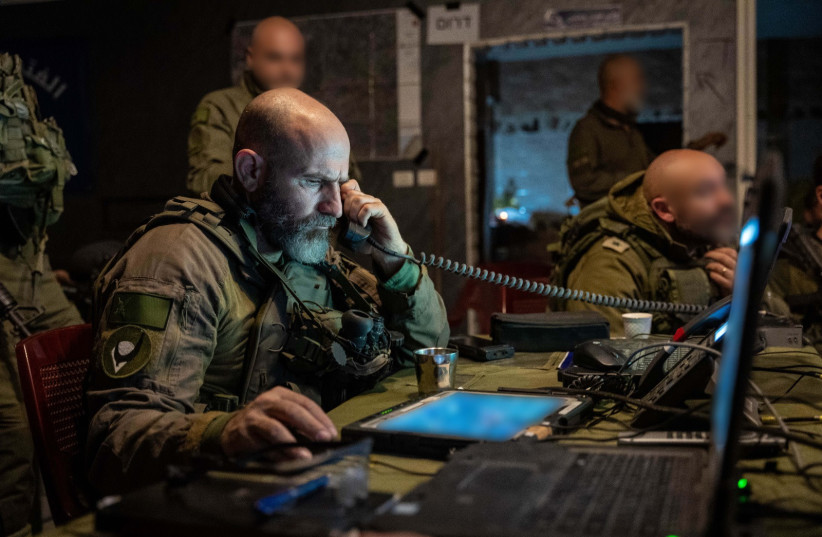
Hamas's deficit by numbers
Of the 4,500 original Hamas fighters, 2,700 have been killed, over 1,000 in close combat and over 1,700 by tank, artillery, or aerial attacks.
Besides attacks on Hamas's terror forces, the IDF has struck 3,320 targets and 400 tunnel shafts in Khan Yunis, 150 of which it has destroyed.
This means that two-thirds of Hamas's Khan Yunis forces have been killed, as well as many other wounded, leaving Hamas forces in the southern "capital" of Gaza even more dilapidated than the terror group is as a whole for the entire Gaza Strip where the percentage of killed is 20-30% and even the percentage of out of commission forces is 48-60%.
All of this progress is despite the fact that the IDF only started invading Khan Yunis in early December, and spent about a month in late December-early January with slower progress.
New progress in Khan Yunis in general, and especially in western Khan Yunis in the last week was made possible partially by a revolutionary change in IDF strategy for confronting the tunnel threat.
When IDF Brig. Gen. Dan Goldfus presented his strategy to a closed group of media outlets earlier in the battle for Khan Yunis, the strategy was to first win the battle above ground, and then to slowly have engineering crews blow up Hamas's underground tunnels as the military found and inspected them.
Often only robots, and at most a small number of soldiers would enter many tunnels.
The original idea was to reduce the dangers to IDF forces of walking into an underground trap.
Later, the IDF shifted to attacking Hamas simultaneously both above and below ground, including sending in full platoons of dozens of IDF forces all at once into the tunnels to combat Hamas terrorists.
Although the IDF fought Hamas in tunnels in northern Gaza and the US has fought adversaries in tunnels in other parts of the world, the concept and implementation of sending large forces into tunnels at the same time as fighting in those areas above ground has not been done before according to the IDF.
These new tactics helped the IDF's 98th Division raid an underground tunnel located under the Bani Suheila cemetery in the heart of Khan Yunis,.
IDF forces not only found explosives, sliding doors, and significant numbers of Hamas terrorists inside, but they also unearthed the office of the eastern Battalion commander from the Khan Yunis Brigade, from where he helped direct the October 7 attacks.
In addition, troops found operation rooms, a battalion combat war room, and bedrooms of senior officials of the Hamas terrorist organization.
The tunnel is part of an underground labyrinth dug by Hamas terrorists which runs a full kilometer long, some 20 meters deep, and contains several complexes, the IDF noted.
During this operation, the IDF also arrested key Hamas officials who are providing critical new intelligence to the military
After inspecting the tunnel, IDF engineering forces destroyed it.
Despite all of these achievements, IDF sources are unsure if they will catch Hamas's leadership and the Israeli hostages they are holding within Khan Yunis.
A rising number of IDF officials believe that portions of Hamas's leadership and their hostages may have fled to Rafah, where there are close to 1.5 million Palestinian civilians to hide among.
Additionally, another 105,000 Palestinian civilians recently left Khan Yunis for other safe zones, with around 20,000-30,000 remaining in Khan Yunis.
There are also suspicions that portions of Hamas's leadership may be hiding with hostages in Khan Yunis safe zones or other safe zones.
The IDF also explained that its experience in Khan Yunis has helped thoroughly categorize Hamas tunnels as strategic-top leadership, battalion-mid-organizational level, and ambush-tactical.
These categories have also helped treat different kinds of tunnels using different IDF tactics.
For example, the IDF in Khan Yunis moved through the full one-kilometer tunnel in a similar time that above ground, it might have only moved a few hundred meters, while in other tunnels, the IDF still might have just blown up.
On the home front, at around 4:50 p.m. on Monday, rocket sirens sounded in Tel Aviv and across central Israel for the first time in three weeks.
Some 11 rockets were fired from southern Khan Yunis, 6 of which were intercepted, according to Hebrew media.
Magen David Adom (MDA) said a car in Rishon Lezion was hit, though no casualties or injuries were reported.
The car hit by rocket debris is owned by Israeli celebrity Guy Geor, who was not in his vehicle at the moment of the barrage.
In addition, the Police Spokesperson said there were no casualties or injuries throughout the area.
Despite the rocket salvo, the pace of Hamas rocket fire has plummeted from hundreds per day in October to 50-70 at a later stage in the war, to dozens last month, to single digits or even zero on many days.
In the North, IAF jets again targeted and destroyed Hezbollah infrastructure in Lebanon less than two hours after the previous attack, the IDF Spokesperson Unit said on Monday.
As part of the attack, significant aspects of the terrorist infrastructure of the organization were destroyed, along with observation posts in the Markaba, A-Taiba, and Maroun el-Ras areas.
Throughout the day, a number of both rocket and anti-tank missile launches were detected from Lebanese territory to the north in multiple rounds.
In response, IDF forces attacked the sources of the fire along with other areas in Lebanese territory, the IDF said.
Earlier on Monday, the IDF said it attacked military buildings being used by Hezbollah terrorists in the Yaroun region of southern Lebanon.
In northern Gaza, the IDF is expected to ramp up its military presence over the upcoming weeks to counter attempts by Hamas to re-establish itself in the area as Israel's focus moved to the south since December-January, Army Radio reported and the Jerusalem Post confirmed.
The Israeli military plans to carry out several divisional raids in the area, some considered extensive, in areas Hamas has targeted in its efforts to reinstate itself in Gaza's northern towns.
Around 2,000 Hamas fighters are still believed to be in northern Gaza among around 200,000 civilians and are said to be trying to reconstitute themselves as a force while Israel’s government lags in implementing its strategy for transitioning northern Gaza into a post-Hamas area.
Some IDF sources dispute attributing the problems to the government dragging its feet, saying that the issue is more tactical, relating to always evolving intelligence and the need to do periodic clean-ups even in areas where Hamas seemed mostly beaten.
However, it was somewhat embarrassing for the IDF to have to start returning more forces to northern Gaza only a few weeks after loudly releasing large numbers of reservists for what was supposed to be a period of months off.
Tal Spungin contributed to this report.
Go to the full article >>IDF unearths Hamas operation room in tunnel under Khan Yunis cemetery
Inside the tunnel, the forces unearthed the office of the eastern Battalion commander from the Khan Yunis Brigade, from where he directed the October 7 attacks, according to the IDF.
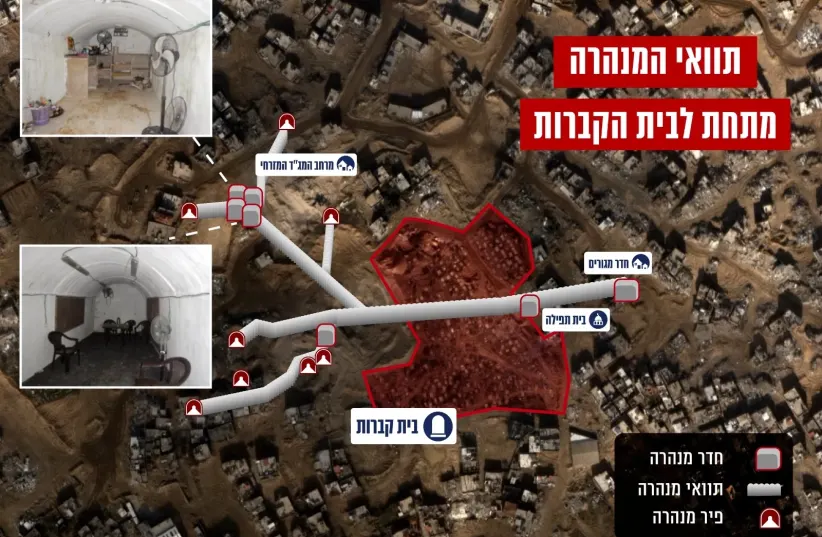
Troops of the 98th Division raided an underground tunnel located under the Bani Suheila cemetery in the heart of Khan Yunis, the IDF reported on Monday. While inspecting the tunnel, the fighters found explosives and sliding doors and eliminated terrorists who were inside.
Inside the tunnel, the Israeli forces unearthed the office of the eastern Battalion commander from the Khan Yunis Brigade, from where he directed the October 7 attacks, according to the IDF.
In addition, troops found operation rooms, a battalion combat war room, and bedrooms of senior officials of the Hamas terrorist organization.
Hamas reportedly used this tunnel to carry out their fight against Israeli forces above and underground.
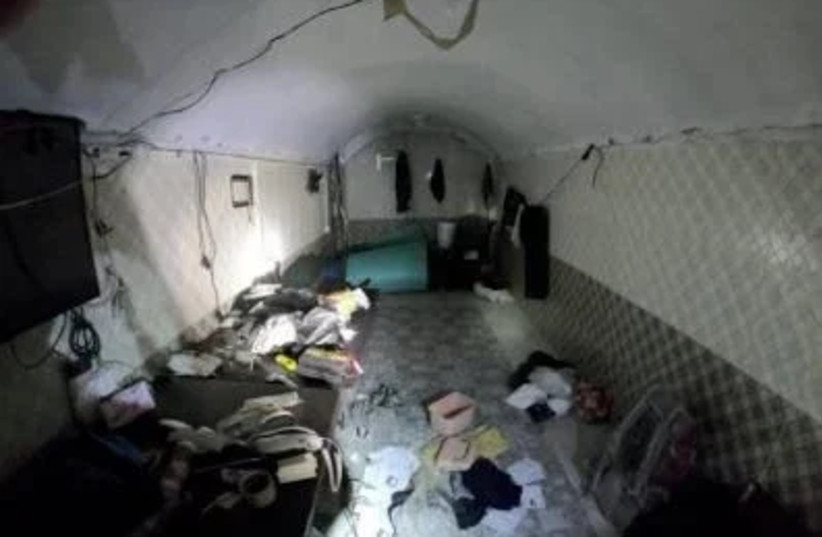
The tunnel is part of an underground labyrinth dug by Hamas terrorists. It is about a kilometer long, some 20 meters deep, and contains several complexes. the IDF noted.
Tunnel destroyed by engineering forces
At the end of the examination, the tunnel was destroyed by engineering forces.
Lt.-Col. Barak, operation branch officer at the 98th Division, said of the find, “We are in the center of the town of Bani Suheila, here in the Gaza Strip, right below the cemetery of Bani Suheila, and we are actually standing at the entrance to a cynical Hamas tunnel, which we are going to enter, you pass under the entire cemetery complex.
"From here is a wide tunnel with rooms, with electricity and running water and all the enabling infrastructure. Behind me is a kitchen complex. The kitchen we are in includes all the appliances.
"We see a wide kitchen in which those cursed terrorists planned to stay during the fighting. This space under the cemetery, tens of meters underground, would have enabled them to live long-term here.
"We know now that in the Guardians of the Walls Operation, this is where the seniors sat and actually managed the fighting," he added.
"We arrived at this complex that is under the cemetery, the same cynical use of a tunnel under a cemetery, just like the same cynical use of tunnels and trapped compounds – in mosques, In schools, in kindergartens."
Go to the full article >>Hamas rejects hostage deal amid Qatari, US optimism
In Washington US Secretary of State Antony Blinken said that the proposal handed to Qatar, “was a strong one and a compelling one that offers some hope."
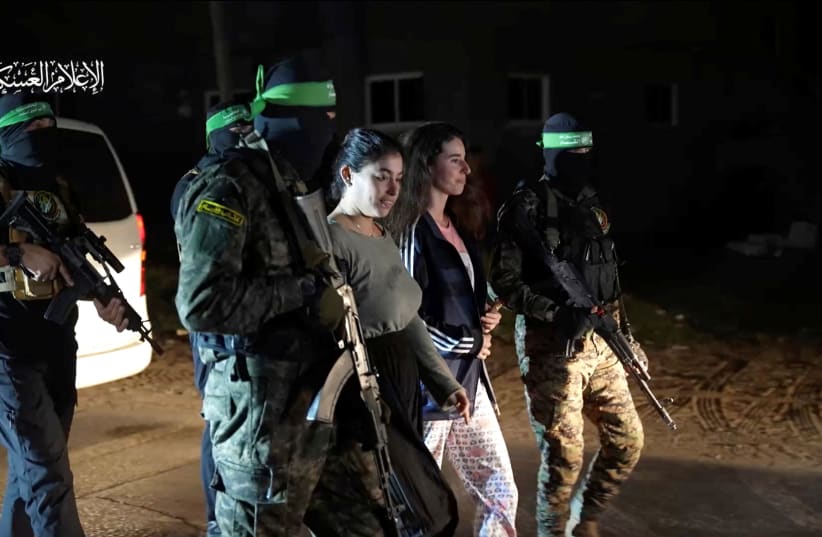
Hamas rejected a hostage deal drafted in Paris over the weekend because it did not include a permanent ceasefire.
Hamas and the Popular Front for the Liberation of Palestine (PFLP) reiterated that Israel must halt its Gaza offensive and withdraw from the Strip before any prisoner exchange takes place, Hamas said in a statement on Monday.
In Washington US Secretary of State Antony Blinken said that the proposal handed to Qatar, “was a strong one and a compelling one that offers some hope that we can get back to this process, but Hamas will have to make its own decisions.”
Blinken spoke amid optimism on the part of the US and Qatar, which along with Egypt is mediating a deal, that a framework had been found for an agreement.
A hostage deal has been a top US priority from day 1, Blinken stated.
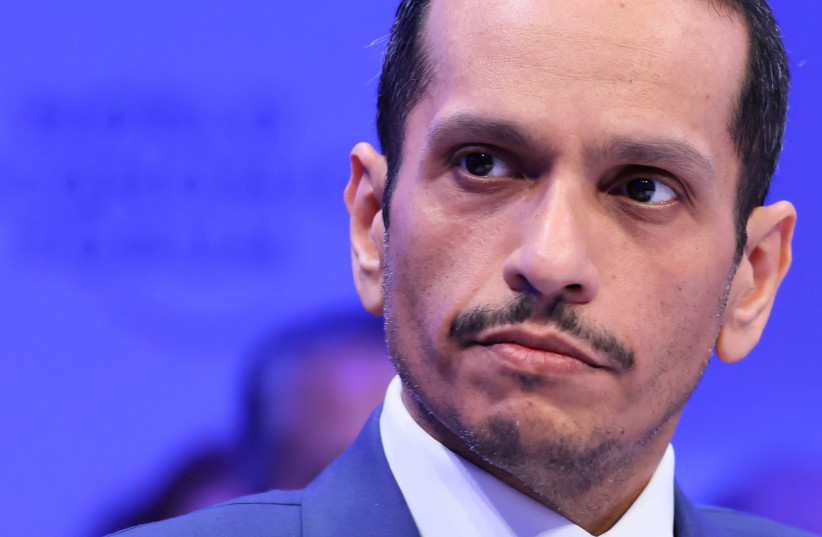
Qatari Prime Minister Mohammed Al-Thani indicated that a hostage deal would be phased with women and children first, as he described the framework agreement that emerged from the Paris talks.
The initial plan for hostage release deal
“The framework that was agreed yesterday with all the parties was a framework based on what has been proposed by the Israelis and what has been a counter-proposal by Hamas,” Thani said during a public interview at an event hosted by think-tank The Atlantic Council.
“We tried to blend things,” he said, adding that this new proposal would now be relayed to Hamas.
Thani arrived from Paris, where he participated in closed-door talks on a deal with CIA Chief William Burns, Mossad Chief David Barnea, Shin Bet Chief Ronen Bar, hostage negotiator Maj.-Gen. (res.) Nitzan Alon, the head of the Egyptian Intelligence Services Abbas Kamel.
Thani said that Hamas rescinded its demand for a permanent ceasefire ahead of any negotiations, but “we moved from that place” to one that could lead to a ceasefire, “which we are all hoping for.”
NBC News Chief Washington Correspondent Andrea Mitchell, who conducted the interview together with David Ignatius of The Washington Post, asked Thani about the details of the deal.
Mitchell explained she understood that there would be “a phased pause in the fighting women and children first, and to continue this in phases as you proceed, with aid going in as well.”
Thani responded, “You are well informed.”
He described how one of the stumbling blocks to the deal had been a Hamas demand for a permanent ceasefire before holding talks, noting that this has now been rescinded.
“There was a clear demand of the permanent ceasefire ahead of the negations,” Thani said, explaining that Qatar had moved Hamas “from that place”, to one “that can lead to a ceasefire in the future. This is what we are all aiming for,” he stated.
The goal of the talks is to free the hostages and to stop the Israeli bombing in Gaza, Thani added.
Advancement in the talks comes as the US is weighing retaliatory military action for an attack that killed three troops in Jordan. Thani said he hoped this would not undercut progress toward a new Israel-Hamas hostage release deal.
“I hope that nothing would undermine the efforts that we are doing or jeopardize the process,” Thani said.
US National Security Council spokesperson John Kirby told MSNBC News that a framework exists for a deal to release the hostages, but he cautioned that nothing had been finalized.
“A lot of promise here, but again, I want to be very clear, there is still diplomacy ahead of us, a lot of discussions to occur before we can get there,” Kirby said.
He clarified, however, that “we don’t have a deal on the table and imminently ready to be announced.”
The US does “think that there is a framework here for another hostage deal that could make a difference in terms of getting more hostages out, getting more aid in, and getting the violence to calm down and that would reduce civilian casualties,” Kirby stated.
He later told reporters that the push was for “a humanitarian pause of sufficient duration that will allow a large number of hostages to be released.” During that period, more humanitarian assistance and go in and casualties will be reduced, Kirby said.
The broad framework under discussion has focused on an exchange of captives for the release of Palestinian security prisoners or terrorists, as well as a pause in the war.
It is presumed that the deal to free the 136 captives would be done in stages, as occurred with the November deal, during which 105 captives were freed during a week-long lull in fighting.
Hamas seized some 253 captives on October 7. KAN News reported that the latest bid to free the hostages included three phases, with the first one focusing on 40 captives including women, children, the elderly, and those who are sick.
The second phase would include male adults who are not soldiers, and the third phase would be for the soldiers, including the female ones.
Part of the deal would include the release of thousands of Palestinian security prisoners, including those convicted of terror offenses, but this latter group is only likely to be part of the agreement at the end.
Hamas said on Monday that releasing hostages it is holding would require a guaranteed end to the war and a full IDF withdrawal.
“The success of the Paris meeting is dependent on the Occupation (Israel) agreeing to end the comprehensive aggression on Gaza Strip,” senior Hamas official Sami Abu Zuhri told Reuters.
Hamas previously said a full release would require that Israel free all of the thousands of Palestinians held on security grounds in its prisons.
A Palestinian official, close to mediation talks, who requested anonymity, said that for Hamas to sign a follow-up deal to the November truce in which it released dozens of hostages, it wants Israel to agree to end the offensive and withdraw from Gaza – through implementation would not necessarily be immediate.
The agreement would have to be endorsed by Qatar, Egypt, and the US, the official said.
Israel has insisted it has no plan to end the war until Hamas is defeated or to relinquish security control of Gaza. One compromise position, however, could be that it would temporarily withdraw from selected target areas.
In an interview with Douglas Murray on Talk TV, Prime Minister Benjamin Netanyahu continued to stress that Qatar could do more to secure a deal, particularly given that top Hamas leadership lived in its country.
“We should demand from Qatar to use their leverage to achieve the release of the remainder of our hostages” as well as to provide proof that hostages have received medications as part of an existing deal with Hamas.
Qatar “has considerable influence [on Hamas] and I expect them to use it,” he stated.
Thani pushed back at Netanyahu’s assertions that the military campaign was an important pressure lever to free the hostages. He said it was “not getting any results to get the hostages back” and that diplomacy was the best route to secure their return.
He also denied claims that Qatar had any special leverage over Hamas, explaining that to the extent it gave them influence, then his country was using that to negotiate a deal.
Qatar’s role is as a mediator that offers solutions, “We do not see that Qatar is a superpower that can impose something on this party.”
Go to the full article >>Forensic accountants work to quantify damage to Kibbutz Be’eri
Amit Solvy, the economic chairman of Kibbutz Be’eri, predicted that the costs of repair would be as high as 600 million shekels ($159 million).

Roughly a dozen Israeli communities in the Gaza periphery were infiltrated by Hamas as part of the terror group’s October 7 massacre. But few, if any, were as utterly devastated as Kibbutz Be’eri.
According to reports, witness testimony, CCTV footage, and first responders, some 90 armed terrorists arrived at Be’eri before 6 a.m. on what came to be known in Israel as “the black Sabbath.” The Hamas fighters kidnapped 25 community members, including 9-year-old Emily Hand. Five Be’eri members who were taken hostage are still being held in Gaza.
Over 130 people of all ages were murdered on the kibbutz. Some were shot to death, while others were burned alive in their homes. According to first responders, 80% of the recovered bodies showed signs of torture. Some victims were found bound up, decapitated, or with signs of sexual abuse.
An entire kibbutz was destroyed
Aside from the enormous human and emotional toll, the buildings of Be’eri were also ravaged. At least half of the kibbutz’s buildings were burned to the ground, with an estimated cost in the hundreds of millions of dollars just to rebuild.
In the months since the attack, teams of experts, including volunteers from within the community, have been working tirelessly to quantify what was lost.
Retired certified public accountant and auditor Mark Linton, who lives in northern Israel’s Kibbutz Kfar Haruv, was among the first to be tapped for this mission. His close friend, 74-year-old Canadian-born peace activist Vivian Silver, was among those who were murdered at Kibbutz Be’eri. It took authorities 38 days to identify her body.

Members of the kibbutz are no longer living on Be’eri, with most having been displaced to hotels and other communities near the Dead Sea. But they rely on the kibbutz accounting department for their salaries.
“Be’eri is known as a traditional kibbutz,” Linton told The Media Line. “They haven’t been privatized, and everything is still very communal. So the importance of the budget that they get is very paramount for them. I work in a privatized kibbutz, so I pretty much get whatever I make from my salary. But they don’t.”
Instead, Be’eri’s members share the wealth generated both by the kibbutz’s industry as well as by the members’ jobs outside the kibbutz. All the income generated by the kibbutz and its members is pooled and then divided, with family budgets “determined by the size of their families, whatever particular needs they have,” Linton explained.
For this reason, kibbutz members were returning to work within days of the October 7massacre.
Amit Solvy, the economic chairman of Kibbutz Be’eri, told The Media Line that hundreds travel to the community every day to rebuild, to work the various industries and businesses on which the kibbutz financially relies, and to otherwise keep the community afloat.
“The kibbutz is full during the day,” he said. “It’s full of people working at the printing press, in agriculture, in carpentry … and the dining room is serving three meals per day.”
By doing this, the kibbutz has also been able to continue paying monthly stipends to its members—relying on previous invoices that were recovered to determine how much each family is owed.
But the kibbutz’s larger financial picture is still lost, and Linton imagines it will take years to fully recover from the mess.
All of Be’eri’s offices were destroyed in the attack, including the accounting office. And of the eight central workers in the accounting department, the chief accountant—55-year-old Ohad Ben Ami—was kidnapped to Gaza, Linton said.
The next four in line were all murdered, “leaving only three people, who were really just starting out in the department, and they don’t know much,” Linton continued. The computers, notes, and papers were destroyed as well.
“I was approached by the head of the company that does the kibbutz’s auditing, and they asked me if I would choose staff and direct them to reinvent the department,” Linton said.
The accounting computers were backed up to the cloud, providing Linton and his team a starting-off point. They had access to information about who the kibbutz owed money to, and who was in debt to the kibbutz. And with that, the team was able to “start doing all the very basic things.”
The complications of rebuilding what was lost
However, the systems in place, the calculations used, and many other records were not recovered, leaving a massive and expensive puzzle to be unraveled. Linton calls the work “forensic accounting.”
“We have to look and see what was done before, and try to guess how they did it,” Linton explained. “And not everything we’re doing is right. Sometimes we get to the same answers in probably a different way. Sometimes we don’t get the right answers at all. It’s very complicated.”
In many cases, the accountants face questions they didn’t know they needed to ask. One example comes from the Be’eri print shop. The print shop does its own business accounting, but every month the kibbutz charges the print shop a certain sum for the labor provided by kibbutz members—effectively collecting wages towards the community’s pooled income.
But Linton doesn’t have any record of how the kibbutz calculates this sum.
“Say you’re a kibbutz member who worked there [at the print shop] 20 days last month…” Linton says he doesn’t know how much the kibbutz should charge the business for this labor. “Are you paid by the hour, by the day, monthly? And there are 100 people like this [for whom they don’t know how to calculate wages].” Yet all these things must be calculated properly and reported to the income tax authorities “because they’re the ones in charge of doling out the [insurance] money to rebuild the kibbutz and to pay for war damages. So we can’t just say, ‘We don’t know, and to hell with it.’”
All told, Linton expects the job to take years to complete, including training a new team of accountants to take over.
Likewise, Solvy says that the community will be moving this summer from resorts near the Dead Sea to a prefab community being built by Kibbutz Hatzerim near Beersheba.
They will live there for at least one and a half years while the 130 or so destroyed buildings on Be’eri are rebuilt and basic infrastructure on the kibbutz is reinstated.
Linton struggled to estimate the damages from the attack. “I could throw out a number and it wouldn’t mean anything,” he said. “Because, first of all, you have to define what you mean by ‘damage.’ Is it just the buildings and the cars and the furniture that was destroyed? How about health problems? How about mental health problems? I don't think anyone has even defined what your question implies.”
That said, Linton concluded that rebuilding a relatively large kibbutz would likely cost over 100 million shekels ($27 million) minimum. “And that’s just the physical,” he said.
Solvy predicted that the costs would be as high as 600 million shekels ($159 million). “And if you want to build a bigger Be’eri—a “Be’eri 2”—then it’s closer to a billion shekels [$265 million],” he said.
The community leaders have been in constant communication with the government to receive state funding earmarked for rebuilding towns in the Gaza envelope. Solvy says roughly 18 billion shekels ($4.8 billion) have been pledged for all the damaged communities in Israel, combined. That budget has yet to receive final approval from the government, however. And the portion Be’eri is set to receive is likewise still unknown.
But no matter how long it takes or how hard they must work, the members are fully intent on returning to their homes. Solvy says the community conducted a poll, and that fewer than 1% indicated that they didn’t want to come back.
Go to the full article >>Defense Minister Gallant: 'Half of Hamas terrorists out of combat'
This statement comes after reports showed that IDF's elimination of Hamas forces had been on the decline.
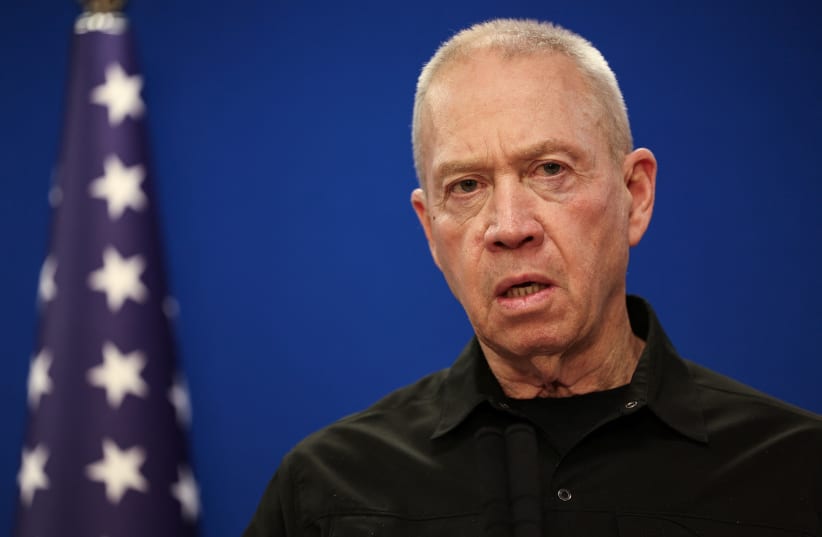
Defense Minister Yoav Gallant spoke to IDF troops in the Gaza border communities and said, "A quarter of the Hamas terrorists were eliminated, and at least another quarter were wounded," Israeli media reported on Monday.
This statement comes after reports showed that IDF's elimination of Hamas forces had been on the decline.
Up until now, it is estimated that 48-60% of Hamas's forces are out of commission due to being either killed, wounded, or arrested.
Up until now, Israel's war against Hamas has consisted of two main objectives: Eliminating Hamas and releasing the Israeli hostages being held captive in Gaza.
A military approach to returning hostages home
Prior to Defense Minister Yoav Gallant's statement regarding Hamas's elimination, in a press conference earlier this month, he spoke about the hostages, claiming that it was too soon for the Israel-Hamas war to come to a conclusion.

"If the war ends now, the fate of the hostages will be sealed for many years- in Hamas captivity," said Gallant.
“Without military pressure, no one will talk to us; without the military pressure, we will not be able to achieve any agreements – only from a position of strength can we ensure the release of hostages,” he added.
A failed attempt at a hostage deal
Despite Israel's attempts this week to form a deal with Hamas that would allow for further Israeli hostages to be released, the drafted deal fell through on Monday night.
The deal was drafted in Paris, and both Qatar and the US were optimistic about it taking place. However, the deal fell through due to Hamas's rejection.
Hama's reasoning for rejecting the deal at play was that it did not include a permanent ceasefire.
Hamas and the Popular Front for the Liberation of Palestine (PFLP) reiterated that Israel must halt its Gaza offensive and withdraw from the Strip before any prisoner exchange takes place, Hamas said in a statement on Monday.
Yonah Jeremy Bob contributed to this report.
Go to the full article >>Israel-Hamas War: What you need to know
- Hamas launched a massive attack on October 7, with thousands of terrorists infiltrating from the Gaza border and taking some 240 hostages into Gaza
- Over 1,200 Israelis and foreign nationals were murdered, including over 350 in the Re'im music festival and hundreds of Israeli civilians across Gaza border communities
- 136 hostages remain in Gaza, IDF says